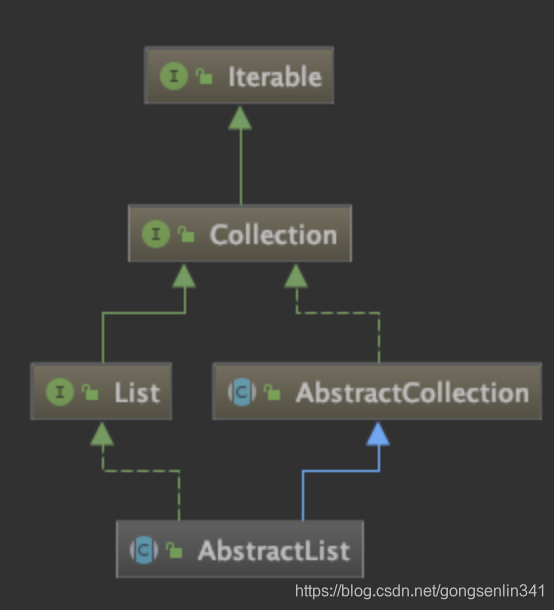文章目录
1.概述
AbstractList是List的抽象实现,
简单实现了一些关于List的基本操作。
2.类图

继承了AbstractCollection抽象集合类,AbstractCollection是java自己提供的一个最基本的Collection的实现。当然它依然是一个抽象类。
对于一个不可更改的集合,只要继承这个类并且实现迭代器和size()方法就行。
对于一个可更改的集合,需要实现add和返回Iterator的方法,当然可选的实现remove方法
实现了List接口,List接口定义了列表的一些基本的方法
3.构造方法
无参构造方法 由protected修饰,说明是外部无法访问的,子类可以在内部使用此构造函数。
protected AbstractList() {
}
4.基本方法
很多方法中都是直接抛出UnsupportedOperationException()异常
这表明当子类继承这个类但没有实现这个方法,却被调用的这个方法的时候就会抛出异常。
public boolean add(E e) { // 添加方法,内部调用add(int index, E element)
add(size(), e);
return true;
}
public void add(int index, E element) {
throw new UnsupportedOperationException();
}
abstract public E get(int index);//抽象方法,获取指定索引的元素
public E set(int index, E element) {//在某个索引位置设置元素
throw new UnsupportedOperationException();
}
public E remove(int index) {//异常索引对应的元素
throw new UnsupportedOperationException();
}
public int indexOf(Object o) {//从前往后找 利用迭代器去寻找指定的元素,返回其位置,没找到的话返回-1
ListIterator<E> it = listIterator();
if (o==null) {
while (it.hasNext())
if (it.next()==null)
return it.previousIndex();
} else {
while (it.hasNext())
if (o.equals(it.next()))
return it.previousIndex();
}
return -1;
}
public int lastIndexOf(Object o) {//从后往前找 利用迭代器去寻找指定的元素,返回其位置,没找到的话返回-1
ListIterator<E> it = listIterator(size());
if (o==null) {
while (it.hasPrevious())
if (it.previous()==null)
return it.nextIndex();
} else {
while (it.hasPrevious())
if (o.equals(it.previous()))
return it.nextIndex();
}
return -1;
}
public void clear() {//内部调用removeRange(int fromIndex, int toIndex),从0到末尾清除
removeRange(0, size());
}
protected void removeRange(int fromIndex, int toIndex) {//protected修饰的方法,不能被外部调用,所以是一个内部的抽取出的一个公共方法。从起始位置fromIndex 到 toIndex的元素删除。前闭后开
ListIterator<E> it = listIterator(fromIndex);
for (int i=0, n=toIndex-fromIndex; i<n; i++) {
it.next();
it.remove();
}
}
public boolean addAll(int index, Collection<? extends E> c) {//将集合c添加到索引index开始的位置 包括index这一位
rangeCheckForAdd(index);//判断索引是否越界
boolean modified = false;
for (E e : c) {
add(index++, e);
modified = true;
}
return modified;
}
public List<E> subList(int fromIndex, int toIndex) {//获得子列表的引用
return (this instanceof RandomAccess ?
new RandomAccessSubList<>(this, fromIndex, toIndex):
new SubList<>(this, fromIndex, toIndex));
}
5.迭代器
5.1获得迭代器
public Iterator<E> iterator() {
return new Itr();
}
list迭代器 第一无参的内部调用listIterator(0),返回一个从索引0开始迭代的迭代器
第二个是根据参数 返回从索引index开始迭代的迭代器
public ListIterator<E> listIterator() {
return listIterator(0);
}
public ListIterator<E> listIterator(final int index) {
rangeCheckForAdd(index);
return new ListItr(index);
}
5.2 Itr
实现了Iterator接口 该接口实现了迭代器的基本方法
5.2.1成员变量
int cursor = 0;//游标 当前索引
int lastRet = -1;//上一次操作的索引
int expectedModCount = modCount;// 预期的修改次数,估计是用于CAS吧
5.2.2基本方法
public boolean hasNext() {//判断是否有下一个元素,当前游标不等于大小就说明有下一个元素
return cursor != size();
}
public E next() {// 获取当前游标元素,并记录这一次操作的位置lastRet 然后游标往后移动一位。返回当前元素。
checkForComodification();
try {
int i = cursor;
E next = get(i);
lastRet = i;
cursor = i + 1;
return next;
} catch (IndexOutOfBoundsException e) {
checkForComodification();
throw new NoSuchElementException();
}
}
public void remove() {
if (lastRet < 0)
throw new IllegalStateException();
checkForComodification();
try {
AbstractList.this.remove(lastRet);//注意移除的是lastRet所指向的元素
if (lastRet < cursor)//若比游标小,游标-1
cursor--;
lastRet = -1;//lastRet设置成-1。连续两次调用remove则会抛出异常。
expectedModCount = modCount;
} catch (IndexOutOfBoundsException e) {
throw new ConcurrentModificationException();
}
}
final void checkForComodification() {//检查当前是否可以进行操作。
if (modCount != expectedModCount)
throw new ConcurrentModificationException();
}
5.3 ListItr
继承了Itr 并实现了ListIterator
5.3.1 构造方法
根据参数设置当前游标
ListItr(int index) {
cursor = index;
}
5.3.2 基本方法
public boolean hasPrevious() {//是否前面有元素
return cursor != 0;
}
public E previous() {//获取前一个元素 同理也是要记录lastRet
checkForComodification();
try {
int i = cursor - 1;
E previous = get(i);
lastRet = cursor = i;
return previous;
} catch (IndexOutOfBoundsException e) {
checkForComodification();
throw new NoSuchElementException();
}
}
public int nextIndex() {//获取当前游标
return cursor;
}
public int previousIndex() {//获取游标前一位索引
return cursor-1;
}
public void set(E e) {//修改元素
if (lastRet < 0)
throw new IllegalStateException();
checkForComodification();
try {
AbstractList.this.set(lastRet, e);//lastRet的元素设置成e
expectedModCount = modCount;
} catch (IndexOutOfBoundsException ex) {
throw new ConcurrentModificationException();
}
}
public void add(E e) {//添加元素
checkForComodification();
try {
int i = cursor;
AbstractList.this.add(i, e);
lastRet = -1;
cursor = i + 1;
expectedModCount = modCount;
} catch (IndexOutOfBoundsException ex) {
throw new ConcurrentModificationException();
}
}
6 子列表subList
仅仅只是拿到原来List的子序列的引用
修改subList 起始就是修改原来的List
private final AbstractList<E> l;
private final int offset;
private int size;
SubList(AbstractList<E> list, int fromIndex, int toIndex) {
if (fromIndex < 0)
throw new IndexOutOfBoundsException("fromIndex = " + fromIndex);
if (toIndex > list.size())
throw new IndexOutOfBoundsException("toIndex = " + toIndex);
if (fromIndex > toIndex)
throw new IllegalArgumentException("fromIndex(" + fromIndex +
") > toIndex(" + toIndex + ")");
l = list;
offset = fromIndex;
size = toIndex - fromIndex;
this.modCount = l.modCount;
}
其他的方法和list差不多 只是需要加上offset偏移量 例如
public E set(int index, E element) {
rangeCheck(index);
checkForComodification();
return l.set(index+offset, element);
}